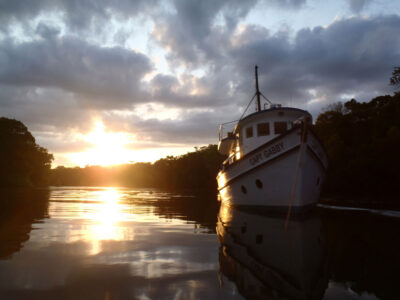
Published May 5, 2022 | Coastlines Georgia | Vol. 5, Iss. 1
By Tyler Jones
Public Information Officer
Coastal Resources Division
Georgia Department of Natural Resources
BRUNSWICK, Ga. — It may be safe to say tarpon had Greg Hildreth hooked long before he hooked a tarpon.
Years before he became a successful Georgia fishing guide and charter captain, Hildreth was a wide-eyed high schooler with a copy of the magazine Florida Sportsman and a few fishing buddies.
“I saw an article about tarpon fishing, and my friends and I thought it looked cool,” he said. “We wanted to try it.”
He and his friends took a john boat to Apalachicola Bay to try their hand, not sure what they were getting into.
“We were just high school kids with no money, and we didn’t really know what we were doing,” he said. “We pulled into West Pass (an area in the bay), and I saw a guy hook one. It jumped out of the water, and I thought, ‘I’ve got to do that.’”
While Hildreth would eventually do just that, his fishing trip in 1979 was not the day.
“Three years later, I still hadn’t hooked one, so I called the guy who wrote that article,” he said. “He agreed to take me out, and we still didn’t catch any tarpon that day, but he showed me everything I was doing wrong.”
The next day, Hildreth finally got his goal.
“We must have hooked about 15 that day with artificial lures,” he said. “It was one of the most thrilling things I’ve ever done. I always tell people that God must love duck hunting, turkey hunting and tarpon fishing, because none of those seasons overlap, so you don’t have to choose which one to do.”
Several decades after that first unsuccessful tarpon trip with the Florida Sportsman writer, Hildreth has managed to turn one of his favorite activities into a career. As a Brunswick-based charter captain, he specializes in taking clients tarpon fishing when the season comes around in late summer.
“I love to catch them,” he said. “But they are hard and tricky to figure out, especially here. Even though you might see them, you won’t catch them every time. People love to catch them—they come from all over.”
Over the years, though, Hildreth has learned a lot about conservation and what it takes to keep tarpon populations healthy for future generations. These massive game fish can grow up to 100 inches in length and take a decade to reach maturity. Although the state men’s record in Georgia is 161 pounds, tarpon have been known to grow well over 200 pounds. Keeping the tarpon population healthy means fish must be able to reach reproductive adulthood. One way anglers can help ensure a healthy tarpon population is by handling them properly, Hildreth said.
“I try to encourage people to leave them in the water,” Hildreth said. “I carry two gloves, and I’ll bring the fish boat side, and once he’s sideways in the water, you pretty much have him. I’ll let people hold the lower jaw and get a photo from above with the fish in the water.”
Removing the fish from the water can present plenty of problems, not the least of which is trying to handle a massive, unpredictable animal. Taking the fish out of the water can also seal its fate and result in its untimely death, Hildreth cautioned.
“Once you start trying to pick that fish up out of the water, that’s when you have problems,” he said. “If you pick it up by the lower jaw, you’re going to break that throat latch. He may swim off, but he’s not fine. He’s going to die. The best thing is to leave them in the water.”
Hildreth recommends handling tarpon in the water and using your hand to hold the fish’s lower jaw. When it’s time to release the fish, turn it upright in the water with the mouth facing toward the front of the boat, directly into the current.
“The current will get oxygen into his gills,” Hildreth said. “He will let you know when he’s ready to go. He’ll shake is head, wag his tail, and swim off.”
It’s tips like these Hildreth has learned in his years as a charter captain. Over the years, the importance of conservation has grown in his mind, and he’s hoping the best practices he teaches his clients will catch on among other anglers.
“Tarpon are a renewable resource,” he said. “That fish can grow to an age of 60 or 70 years old, and there’s no need to kill a creature like that. Nowadays, it goes a lot further to release that fish so it can be caught again and stay a renewable resource. Years ago, people just didn’t know any better. They thought there were so many fish that it didn’t matter if you killed it and hung it up at the dock. But we know that’s not true anymore.”
Ryan Harrell, a CRD marine biologist who works with the Marine Sportfish Population Health Survey, echoed Hildreth and said anglers don’t necessarily need to cause the death of a fish to have a trophy.
“The days of bringing tarpon to the dock are no longer celebrated,” Harrell said. “For angers wanting a trophy, fiberglass reproductions are now available. All you need is the length, girth and a photograph of your catch, which can all be accomplished without removing the fish from the water. Online calculators are also available to estimate the weight of a fish without having to hang them on a scale.”
Harrell isn’t alone in the scientific community with his advice on proper handling.
Aaron Adams, director of Science and Conservation with the Miami-based Bonefish and Tarpon Trust, said conservation today means fishing tomorrow.
“If anglers want to ensure they can go out and catch tarpon in 10 years, they better start treating them right in handling and be involved in other aspects of conservation,” he said. “There are not as many tarpon today as there were 50 years ago, and the only way to have them around in abundance is to follow best practices that we find appropriate. It’s not just about the fish and the fishery–it’s about behaving responsibly.”


